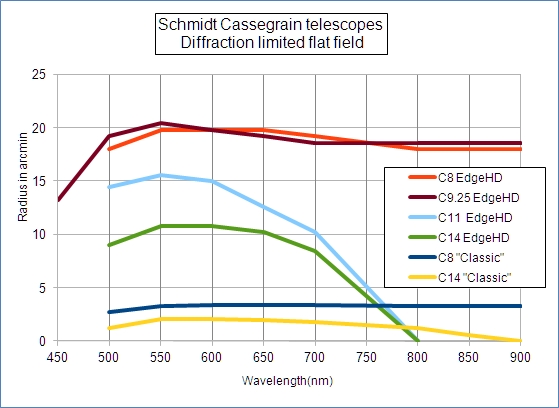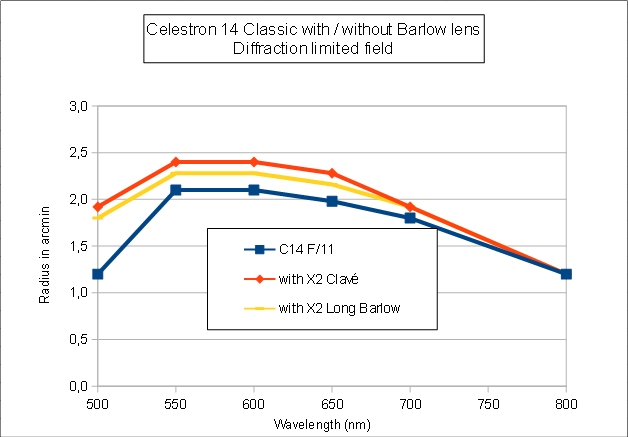OLSO models :
- Two OSLO models for the C14-Edge HD were estimated by Vladimir Sacek. They are "best guess" based on data available and two options for the correction of spherical aberration (neutral point at 0.866 and at 0.707 radius).
- The model for the "classic" C14 is from Ken Hutchisson and Thierry Berthe, and is a "best guess" given actual measurements and data available.
Radius of the diffraction limited flat field :
- Classic C14 : about 0.035°, in green light, found by OSLO simulation, ie equivalent to a Newton F/4.4. This is just enough to cover the width of the CMOSIS 4000 at 0.13arcsec/pixel (2000 x 2000 pixels), but of course not the diagonal ...
- C14 Edge-HD : 0.207° in green light according to Celestron WhitePaper (this compares very well with the 0.18° radius found in the OSLO simulation of the model with a neutral point at 0.707 radius.

Radius of the diffraction limited flat field with / without Barlow lenses(classic C14) :

Field curvature :
- C14 : Petzval radius = -309 mm
- C14 Edge-HD : flat-field.
Sensitivity to backfocus (Classic C14):

Strehl ratio versus wavelength (on axis):
Given the uncertainties on the OSLO models, the classic and Edge-HD C14 performances versus wavelenghts look similar.

Focus versus wavelength (obsolete figure ...to be updated):

Sensitivity to primary mirror tilt (image shifting) - Comparison of the Classic and Edge-HD version :
Thanks to its much larger diffraction limited field, the C14 HD-Edge is much less sensitive to mirror tilt than the C14. This is illustrated by the following table which gives the on-axis Strehl ratio (550 nm) for various amount of M1 tilt.
| M1 tilt | C14 | C14 Edge-HD |
|---|---|---|
| 0.01° |
0.92
|
0.97
|
| 0.02° |
0.72
|
0.90
|
The C14 is no longer diffraction limited for a 0.02° tilt, while the C14 Edge-HD is still above the 0.80 limit.
Sensitivity to primary mirror tilt (image shifting) for the C14 Classic :
The "classic" C14 suffers from "image shifting" due to tolerance ajustement on the baffle tube. The objective of this part is to check out the influence of this "image shifting" on the quality of the images.
A maximum tilt of 0.01° of the primary mirror is assumed. This value comes from various approaches :
- measurements on an optical bench (double path collimation) : the focus can be offset by up to 1 mm radially by pushing / pulling hard on the primary mirror cell. Given the focal lenght of the C14, this is an angle of about 0.02°, so a 0.02/2 =0.01° tilt of the primary mirror.
- the length of the baffle supporting the primary mirror cell is about 200 mm, assuming a 0.02 mm difference of radius between the inner and outer part (which would be a very large tolerance), we have a maximum tilt of about arctg (0.02/200) = 0.006°
- in pratical life, the amount of shifting when focussing with the primary miroir is lower than 20 arcsec, which means a max tilt of the primary miroir of about 0.005°.
Accordingly, a maximum tilt of 0.01° looks like a realistic worst case value to do some simulations.
The following figure illustrates the result of a 0.01° tilt on the primary mirror. Basically, the "sweet spot "is now offset by about 0.02°. There is now some astigmatism on-axis (not visible in the spot diagram), still the image on-axis is 0.23 L PV et 0.044 L rms .

Now, if the secondary mirror is tilted by 0.022° to correct the tilt of the primary, the image is perfect again on axis with no trace of astigmatism :

In conclusion, the tilt of the primary mirror due to "image shifting" has very probably no negative consequence on image quality on axis as far as it is corrected by a tilt on the secondary mirror.